 W
WAfter Burner is an arcade vehicular combat game developed and released by Sega in 1987. The player assumes control of an American F-14 Tomcat fighter jet, and must clear each of the game's eighteen unique stages by destroying incoming enemies, using both a machine gun and a limited supply of heat-seeking missiles. It uses a third-person perspective, previously utilized by Sega's earlier games Space Harrier (1985) and Out Run (1986), and runs on the Sega X Board arcade system, which is capable of surface and sprite rotation. It is the fourth Sega game to use a hydraulic "taikan" motion simulator arcade cabinet, one that is more elaborate than their earlier "taikan" simulator games. The cabinet simulates an aircraft cockpit, with flight stick controls, a chair with seatbelt, and hydraulic motion technology that moves, tilts, rolls and rotates the cockpit in sync with the on-screen action.
 W
WAltered Beast is a 1988 beat 'em up arcade game developed and manufactured by Sega. The game is set in Ancient Greece and follows a player character chosen by Zeus to rescue his daughter Athena from the demonic ruler of the underworld, Neff. Through the use of power-ups, the player character can assume the form of different magical beasts. After its initial arcade release, it was ported to several home video game consoles and home computers, including the Sega Genesis, for which it was a pack-in game.
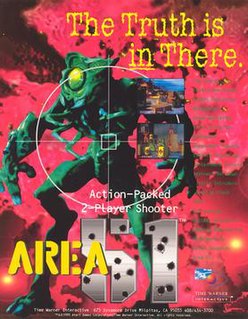 W
WArea 51 is a light gun arcade game released by Atari Games in 1995. It takes its name from the military facility. The plot of the game involves the player taking part in a Strategic Tactical Advanced Alien Response (STAAR) military incursion to prevent aliens, known as the Kronn, and alien-created zombies from taking over the Area 51 military facility.
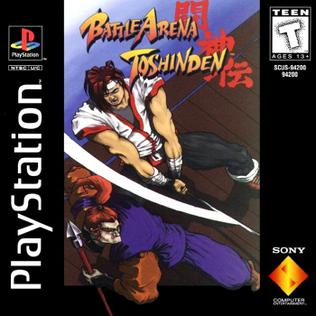 W
WBattle Arena Toshinden is a weapons-based fighting game developed by Tamsoft and published by Takara and Sony Computer Entertainment in 1995 for the PlayStation, followed by 1996 ports for the Sega Saturn, Game Boy and MS-DOS. It was one of the first fighting games to boast polygonal characters in a 3D environment, and features a sidestep maneuver which is credited for taking the genre into "true 3D." The Game Boy version of Battle Arena Toshiden despite sharing the same name as the console & PC counterparts is a different game. It is a 2D weapons based fighter and supports the Super Game Boy cartridge peripheral for the Super Nintendo Entertainment System/Super Famicom to allow the game to be played on a TV with colour palettes and borders.
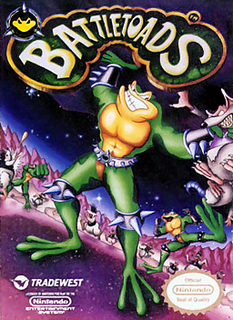 W
WBattletoads is a beat 'em up/platform video game developed by Rare and published by Tradewest. It is the first installment of the Battletoads series and was originally released on 1 June 1991 for the Nintendo Entertainment System. It was subsequently ported to the Mega Drive and Game Gear in 1993, to the Amiga and Amiga CD32 in 1994, and released with some changes for the Game Boy in 1993 in the form of Battletoads in Ragnarok's World. In the game, three space humanoid toad warriors form a group known as the Battletoads. Two of the Battletoads, Rash and Zitz, embark on a mission to defeat the evil Dark Queen on her planet and rescue their kidnapped friends: Pimple, the third member of the Battletoads, and Princess Angelica.
 W
WBrain Warp is an electronic audio game designed and showcased by Big Monster Toys, and was manufactured and published by Tiger Electronics and released on June 16, 1996. In this game, players follow the spoken instructions from sound files spoken from the game unit. The player has to rotate the game in different directions so that the correct color is facing upwards. Its catchphrase which the voice says before a game begins is: "If you don't keep up with me, you're finished!". When you fail a game, the game unit will say "this game is finished" and then it will say "wanna warp again?". A Star Wars version titled Death Star Escape was released by Tiger Electronics in 1997 and the games are called Challenges.
 W
WBug! is a platform video game developed by Realtime Associates and published by Sega originally for its console, the Sega Saturn. It was first released in North America, in 1995, just weeks after the Saturn's launch there; in Europe on September 15, 1995; and, in Japan, on December 8 the same year. It was also ported to Windows 3.1x and Windows 95 in 1996 by Beam Software. Notably, the game is one of the earliest examples of 3D platforming, as well as one of the first platform games released on the Saturn. However, its style of 3D platforming is restricted to a track, unlike many in the genre that allow for unrestricted movement in all directions.
 W
WCastlevania II: Simon's Quest is a platform-adventure game produced by Konami. It was originally released in Japan in 1987 for the Famicom Disk System, and in North America in 1988 for the Nintendo Entertainment System, respectively. It is the second Castlevania game released for the NES, following the original Castlevania in 1986. Set sometime after the events of the first installment, the player once again assumes the role of vampire hunter Simon Belmont, who is on a journey to undo a curse placed on him by Dracula at the end of their previous encounter. Dracula's body was split into five parts, which Simon must find and bring to the ruins of Castle Dracula and defeat him. The game notably deviates from the traditional platforming of its predecessor, incorporating role-playing and open world elements.
 W
WCastlevania: Symphony of the Night is an action role-playing game developed and published by Konami for the PlayStation. It was directed and produced by Toru Hagihara, with Koji Igarashi acting as assistant director. It is a direct sequel to Castlevania: Rondo of Blood, taking place four years later. It features Dracula's dhampir son Alucard as the protagonist, rising from his slumber to explore Dracula's castle which resurfaced after Richter Belmont vanished. Its design marks a break from previous entries in the series, re-introducing the exploration, nonlinear level design, and role-playing elements first experimented with in Castlevania II: Simon's Quest.
 W
WDouble Dragon is a 1987 beat 'em up video game developed by Technōs Japan and distributed by Taito for arcades across Asia, North America and Europe. The game's development was led by Yoshihisa Kishimoto, and it is a spiritual and technological successor to Technos' earlier beat 'em up, Nekketsu Kōha Kunio-kun (1986), released outside of Japan by Taito as Renegade; Kishimoto originally envisioned it as a direct sequel and part of the Kunio-kun series, before making it a new game with a different cast and setting.
 W
WDouble Dragon 3: The Rosetta Stone is a side-scrolling beat 'em up arcade game produced by Technōs Japan in 1990. It is the third arcade game in the Double Dragon series. Unlike the previous two games in the series Double Dragon 3 was not developed internally at Technōs, but development was instead contracted to the company East Technology, resulting in a game that looks and plays differently from its predecessors.
 W
WDouble Dragon II: The Revenge is a side-scrolling beat 'em up produced by Technōs Japan originally released as a coin-operated arcade game in 1988. It is the first sequel to Double Dragon, released during the previous year. The sequel involves Billy and Jimmy Lee in a mission to avenge Billy's girlfriend Marian after she is shot to death by the Black Warriors leader Willy, who is retaliating against the Lee brothers after his defeat at the end of the previous game. Double Dragon II was initially developed as an upgrade kit for the original Double Dragon, but evolved into a stand-alone game due to an increase in memory size, resulting in the developers reusing assets for both games.
 W
WDouble Dragon II: The Revenge is a side-scrolling beat-'em-up produced for the Nintendo Entertainment System in the end of 1989. It is the second Double Dragon game for the NES and was published in North America by Acclaim Entertainment, who took over publishing duties from Tradewest. The game shares its title with the 1988 arcade sequel to the original Double Dragon, using the same promotional artwork for its packaging and having a similar plot, but the content of the two games are otherwise drastically different. The NES version of Double Dragon II was directed by Hiroyuki Sekimoto, with the arcade version's director Yoshihisa Kishimoto taking a supervisory role in the game's development.
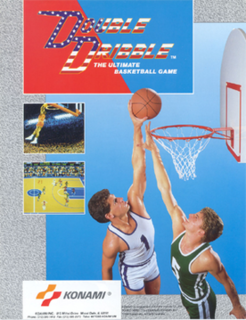 W
WDouble Dribble is an arcade basketball video game developed and released by Konami in 1986. It was the second basketball arcade video game by Konami, following Super Basketball. It was considered the most realistic basketball sports video game upon release, with fast-paced action, detailed players, a large side-scrolling court, innovative cinematic slam dunks, and detailed sound effects, beginning a trend where presentation would play an increasingly important role in sports games.
 W
WDuckTales is an American animated television series produced by Disney Television Animation. The original cartoon series premiered on syndication and on Disney Channel on September 18, 1987 and ran for a total of 100 episodes over four seasons, with its final episode airing on November 28, 1990. Based upon Uncle Scrooge and other Duck universe comic books created by Carl Barks, the show follows Scrooge McDuck, his three grandnephews Huey, Dewey, and Louie, and close friends of the group, on various adventures, most of which either involve seeking out treasure or thwarting the efforts of villains seeking to steal Scrooge's fortune or his Number One Dime.
 W
WDuke Nukem 3D is a first-person shooter video game developed by 3D Realms. It is a sequel to the platform games Duke Nukem and Duke Nukem II, published by 3D Realms.
 W
WGargoyles is an animated television series produced by Walt Disney Television Animation, in collaboration with Jade Animation and Tama Productions for its first two seasons and Nelvana for its final, and originally aired from October 24, 1994, to February 15, 1997. The series features a species of nocturnal creatures known as gargoyles that turn to stone during the day. After spending a thousand years in an enchanted petrified state, the gargoyles are reawakened in modern-day New York City, and take on roles as the city's secret night-time protectors.
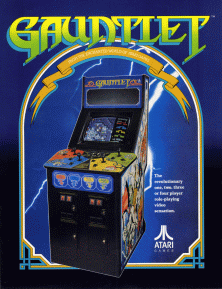 W
WGauntlet is a 1985 fantasy-themed hack-and-slash arcade game developed and released by Atari Games. It is noted as being one of the first multiplayer dungeon crawl arcade games. The core design of Gauntlet comes from 1983 Atari 8-bit dungeon crawl game Dandy, which resulted in a threat of legal action. It also bears striking similarities to the action-adventure maze game Time Bandit (1983).
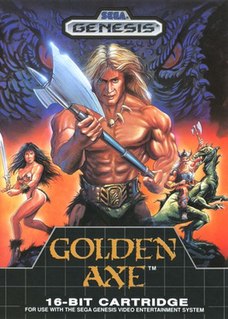 W
WGolden Axe is a side-scrolling hack-and-slash video game released by Sega for arcades in 1989, running on the Sega System 16-B arcade hardware. Makoto Uchida was the lead designer of the game, and was also responsible for the creation of the previous year's Altered Beast. The game casts players as one of three warriors who must free the fantastical land of Yuria from the tyrannical rule of Death Adder, who wields the titular Golden Axe.
 W
WGoldenEye is a third-person shooter handheld electronic game developed and published by Tiger Electronics, based on the 1995 James Bond film of the same name, released between 1995 and 1998. The game was released in two versions, both small handheld dedicated consoles with a similar gameplay: the player controlled James Bond as he fights enemies loosely based on the ones from the film before a GoldenEye satellite destroyed the city with its electromagnetic pulse weapon.
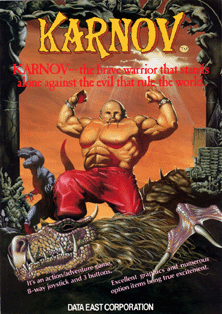 W
WKarnov (カルノフ) is a platform game released in arcades in 1987. A Nintendo Entertainment System port followed. Players take control of the title character Jinborov Karnovski, or "Karnov" for short. Karnov is a strongman popularly illustrated as being from an unspecified part of the Soviet Union's Central Asian republics as shown on the arcade flyer and again in Karnov's Revenge.
 W
WThe Little Mermaid is a Disney media franchise. The success of the 1989 American animated feature film The Little Mermaid led to a direct-to-video sequel, a prequel film, a spin-off television series, a musical, several video games, theme park attractions, and other merchandise. A live action remake of the film is in development for release in 2023. The Little Mermaid paved the way for what would become the Disney Renaissance, with the original film becoming the first film of that era.
 W
WMadden NFL '95 is a football video game. It features John Madden on the cover. It was released as Madden '95 on the Game Boy. It was the first version of the game, which portraited NFL players as black athletes, rather than white as in previous version and the first sports game to portray black athletes on the cover.
 W
WMarble Madness is an arcade video game designed by Mark Cerny and published by Atari Games and Midway Games in 1984. It is a platform game in which the player must guide a marble through six courses, populated with obstacles and enemies, within a time limit. The player controls the marble by using a trackball. Marble Madness is known for using innovative game technologies: it was Atari's first to use the Atari System 1 hardware, the first to be programmed in the C programming language, and one of the first to use true stereo sound.
 W
WMega Man 2: The Mystery of Dr. Wily is an action game developed and published by Capcom for the Nintendo Entertainment System. It was released in Japan in 1988 and in North America and PAL regions the following years. Mega Man 2 continues Mega Man's battle against the evil Dr. Wily and his rogue robots. It introduced graphical and gameplay changes, many of which became series staples.
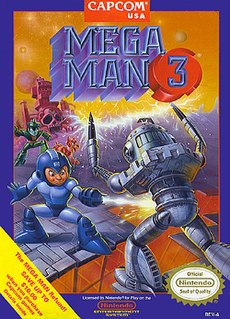 W
WMega Man 3: The End of Dr. Wily!? is an action-platform video game developed and published by Capcom for the Nintendo Entertainment System. It is the third game of the original Mega Man series and was originally released in Japan on September 28, 1990. The game localized in North America later in 1990 and in European regions in 1992. Taking place after the events of Mega Man 2, the plot follows the titular hero as he helps his creator, Dr. Light, and a former villain, Dr. Wily, collect parts for a peace-keeping robot by defeating several Robot Masters that have gone haywire.
Mortal Kombat is an arcade fighting game developed and published by Midway in 1992. It is the first entry in the Mortal Kombat series and subsequently was released by Acclaim Entertainment for nearly every home platform of the time. The game focuses on several characters of various intentions who enter a martial arts tournament with worldly consequences. It introduced many key aspects of the Mortal Kombat series, including the unique five-button control scheme and gory finishing moves called Fatalities.
 W
WMs. Pac-Man is a 1982 maze arcade game developed by General Computer Corporation and published by Midway. It is the first sequel to Pac-Man (1980) and the first entry in the series to not be made by Namco. Controlling the titular character, the player is tasked with eating all of the pellets in an enclosed maze while avoiding four colored ghosts. Eating the larger “power pellets” lets the player eat the ghosts, who turn blue and flee.
 W
WNBA Jam is a basketball video game developed and published by Midway for arcades in 1993. It is the first entry in the NBA Jam series. The project leader for this game was Mark Turmell.
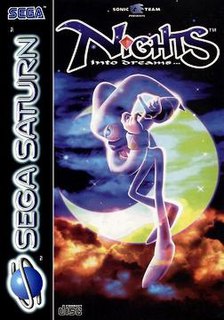 W
WNights into Dreams is a 1996 action game developed by Sonic Team and published by Sega for the Sega Saturn. The story follows teenagers Elliot Edwards and Claris Sinclair, who enter Nightopia, a dream world where all dreams take place. With the help of Nights, an exiled "Nightmaren", they begin a journey to stop the evil ruler Wizeman from destroying Nightopia and consequently the real world. Players control Nights flying through Elliot and Claris's dreams to gather enough energy to defeat Wizeman and save Nightopia. The game is presented in 3D and imposes time limits on every level, in which the player must accumulate points to proceed.
 W
WOut Run is an arcade driving video game released by Sega in September 1986. It is known for its pioneering hardware and graphics, nonlinear gameplay, a selectable soundtrack with music composed by Hiroshi Kawaguchi, and the hydraulic motion simulator deluxe arcade cabinet. The goal is to avoid traffic and reach one of five destinations.
 W
WPac-Man is a 1980 maze action video game developed and released by Namco for arcades. The original Japanese title of Puck Man was changed to Pac-Man for international releases as a preventative measure against defacement of the arcade machines by changing the P to an F. In North America, the game was released by Midway Manufacturing as part of its licensing agreement with Namco America. The player controls Pac-Man, who must eat all the dots inside an enclosed maze while avoiding four colored ghosts. Eating large flashing dots called "Power Pellets" causes the ghosts to turn blue, allowing Pac-Man to eat them for bonus points.
 W
WPaperboy is an arcade action game developed and published by Atari Games and Midway Games, and released in 1985. The player takes the role of a paperboy who delivers a fictional newspaper called The Daily Sun along a suburban street on his bicycle. The arcade version of the game featured bike handlebars as the controller.
 W
WPit-Fighter is a 1990 arcade fighting game by Atari Games which uses digitized live actors. It was Atari's first fighting game. The Japanese arcade release was published by Konami. Home versions were published by Tengen.
 W
WShinobi (忍) is a side-scrolling hack-and-slash action game produced by Sega, originally released for arcades on the Sega System 16 board in 1987. The player controls ninja Joe Musashi, to stop the Zeed terrorist organization from kidnapping students of his clan.
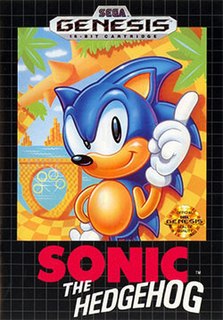 W
WSonic the Hedgehog is a platform video game developed by Sonic Team and published by Sega for the Sega Genesis home video game console. The first game in the Sonic the Hedgehog franchise, it was released in North America in June 1991 and in PAL regions and Japan the following month. The game features Sonic the Hedgehog, who can run at supersonic speeds, setting out on a quest to defeat Dr. Robotnik, a scientist who has imprisoned animals in robots and seeks the powerful Chaos Emeralds. The gameplay involves collecting rings as a form of health, and a simple control scheme, with jumping and attacking controlled by a single button.
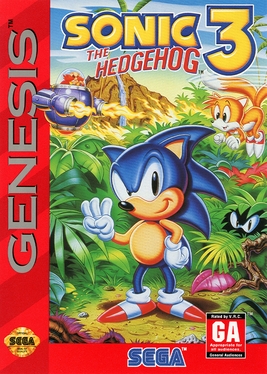 W
WSonic the Hedgehog 3 is a 1994 platform game developed and published by Sega. Like previous Sonic games, players traverse side-scrolling levels at high speeds while collecting rings and defeating enemies. They control Sonic and Tails, who attempt to retrieve the Chaos Emeralds to stop the evil Doctor Robotnik from relaunching his space station, the Death Egg, after it crash-lands on a mysterious floating island. Sonic 3 introduces Knuckles the Echidna, the island guardian, who lays traps for Sonic and Tails.
 W
WSpace Harrier is a third-person arcade rail shooter game developed by Sega and released in 1985. Originally conceived as a realistic military-themed game played in the third-person perspective and featuring a player-controlled fighter jet, technical and memory restrictions resulted in Sega developer Yu Suzuki redesigning it around a jet-propelled human character in a fantasy setting. The arcade game is controlled by an analog flight stick while the deluxe arcade cabinet is a cockpit-style hydraulic motion simulator cabinet that tilts and rolls during play, for which it is referred as a taikan (体感) or "body sensation" arcade game in Japan.
 W
WSpace Invaders is a 1978 shoot 'em up arcade game developed by Tomohiro Nishikado. It was manufactured and sold by Taito in Japan, and licensed by the Midway division of Bally for overseas distribution. Space Invaders was the first fixed shooter and set the template for the shoot 'em up genre. The goal is to defeat wave after wave of descending aliens with a horizontally moving laser to earn as many points as possible.
 W
WStreet Fighter II: The World Warrior is a competitive fighting game developed by Capcom and originally released for arcades in 1991. It is the second installment in the Street Fighter series and the sequel to Street Fighter, released in 1987. It is Capcom's fourteenth game to use the CP System arcade system board. Street Fighter II improved many of the concepts introduced in the first game, including the use of special command-based moves, combo system, six-button configuration, and wider selection of playable characters, each with unique fighting style. It prominently features a popular two-player mode that obligates direct, human-to-human competitive play which prolonged the survival of the declining video game arcade business market by stimulating business and driving the fighter genre. It inspired grassroots tournament events, culminating into Evolution Championship Series (EVO). Street Fighter II shifted the arcade competitive dynamic from high score into human competition, including large groups.
 W
WStrider is a side-scrolling action-adventure game released by Capcom for the Nintendo Entertainment System in North America in 1989. While the development of the NES version of Strider was produced in tandem with the arcade version, the Japanese version for the Famicom was never released. The NES version of Strider is included in the 2006 Game Boy Advance compilation Capcom Classics Mini-Mix.
 W
WTaleSpin is a video game for the Sega Genesis, TurboGrafx-16, and Game Gear. It is based on the Disney animated series with the same name. Sega released the game on the Sega Mega Drive/Genesis in 1992 and Sega Game Gear in 1993. NEC made its own game for their TurboGrafx-16 system in 1991.
 W
WYou Don't Know Jack is a series of video games developed by Jackbox Games and Berkeley Systems, as well as the title of the first You Don't Know Jack game in the series. You Don't Know Jack, framed as a game show "where high culture and pop culture collide", combines trivia with comedy. While it is primarily a PC and Mac-based franchise with over two dozen releases and compilations for those platforms, there have been a few entries released for consoles: two for the original PlayStation, and the 2011 release which had versions for the Xbox 360, PlayStation 3, Nintendo DS and Wii. In 2012, Jackbox Games developed and published a social version of the game on Facebook with cross-platform versions subsequently released for iOS, Android and Kindle. On November 5, 2013, the majority of the franchise's many volumes and spinoffs were reissued onto Steam by Jackbox Games. On November 18, 2014, You Don’t Know Jack 2015 was released as part of The Jackbox Party Pack on Windows, macOS, Xbox 360, Xbox One, PlayStation 3, PlayStation 4, and later Nintendo Switch, iPad, Amazon Fire TV, Android TV, Nvidia Shield, Apple TV, and Xfinity X1. On October 17, 2018, You Don't Know Jack: Full Stream was released as part of The Jackbox Party Pack 5 for the same platforms as You Don't Know Jack 2015.